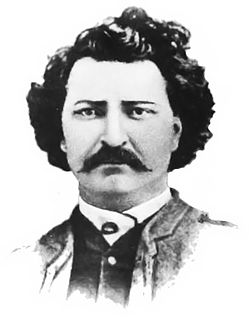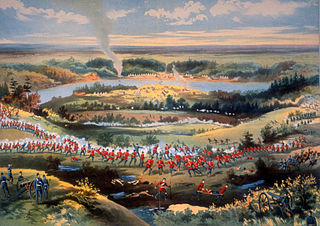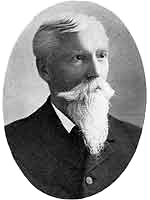
Louis "David" Riel was a Canadian politician, a founder of the province of Manitoba, and a political leader of the Métis people. He led two resistance movements against the government of Canada and its first prime minister, John A. Macdonald. Riel sought to defend Métis rights and identity as the Northwest Territories came progressively under the Canadian sphere of influence.

The North-West Rebellion of 1885 was a rebellion by the Métis people under Louis Riel and an associated uprising by First Nations Cree and Assiniboine of the District of Saskatchewan against the Canadian government. Many Métis felt that Canada was not protecting their rights, their land, and their survival as a distinct people.

Fort Garry, also known as Upper Fort Garry, was a Hudson's Bay Company trading post at the confluence of the Red and Assiniboine rivers in what is now downtown Winnipeg. It was established in 1822 on or near the site of the North West Company's Fort Gibraltar established by John Wills in 1810 and destroyed by Governor Semple's men in 1816 during the Pemmican War. Fort Garry was named after Nicholas Garry, deputy governor of the Hudson's Bay Company. It served as the centre of fur trade within the Red River Colony. In 1826, a severe flood destroyed the fort. It was rebuilt in 1835 by the HBC and named Upper Fort Garry to differentiate it from "the Lower Fort," or Lower Fort Garry, 32 km downriver, which was established in 1831. Throughout the mid-to-late 19th century, Upper Fort Garry played a minor role in the actual trading of furs, but was central to the administration of the HBC and the surrounding settlement. The Council of Assiniboia, the administrative and judicial body of the Red River Colony mainly run by Hudson's Bay Company officials, met at Upper Fort Garry.

The Red River Rebellion, also known as the Red River Resistance, Red River uprising, or First Riel Rebellion, was the sequence of events that led up to the 1869 establishment of a provisional government by the Métis leader Louis Riel and his followers at the Red River Colony, in what was the early stages of establishing today's Canadian province of Manitoba. It had earlier been a territory called Rupert's Land and been under control of the Hudson's Bay Company before it was sold.

St. Boniface is a city ward and neighbourhood in Winnipeg. Along with being the centre of the Franco-Manitoban community, it ranks as the largest francophone community in Western Canada.

Robert Atkinson Davis was a businessman and Manitoba politician who served as the fourth Premier of Manitoba.

Marc-Amable Girard was the second Premier of the Western Canadian province of Manitoba, and the first Franco-Manitoban to hold that post. The Canadian Parliamentary Guide lists Girard as having been Premier from 1871 to 1872, but he did not have this title at the time and was not the government leader. In 1874, however, Girard led Manitoba's first ministry to be constituted on principles of "responsible government". In this sense, he may be regarded as the first Premier of Manitoba.

Thomas Scott was an Irish Protestant who emigrated to Canada in 1863. While working as a labourer on the "Dawson Road Project", he moved on to Winnipeg where he met John Christian Schultz and fell under the influence of the Canadian Party. His political involvement in the Red River Settlement from then on led to his capture at Fort Garry where he was held hostage with others. On 4 March 1870 Scott was marched out of Fort Garry's east gate and was executed on the wall by the provisional government of the Red River Settlement led by Louis Riel.

Government House of Manitoba is the official residence of the Lieutenant Governor of Manitoba, as well as that in Winnipeg of the Canadian monarch. It stands in the provincial capital, on the grounds of the Manitoba Legislative Building, at 10 Kennedy Street; unlike other provincial Government Houses in Canada, this gives Manitoba's royal residence a prominent urban setting, though it is surrounded by gardens.

Riel is a provincial electoral division in the Canadian province of Manitoba. It was created by redistribution in 1968, and has formally existed since the provincial election of 1969. The riding is located in the south-central region of the City of Winnipeg, and is named after Louis Riel, the leader of the 1870 Red River Rebellion.
Fort Garry is a provincial electoral division in the Canadian province of Manitoba that existed from 1958 to 2011 and was re-created in 2019. It was first created by redistribution in 1957 from parts of Iberville, Assiniboia and St. Boniface, and formally existed beginning with the 1958 provincial election. The riding is in the south-central and southwestern region of the city of Winnipeg. It is named for the historical Fort Garry which was occupied by supporters of Louis Riel during the Red River Rebellion of 1870.

The Wolseley expedition was a military force authorized by Canadian Prime Minister John A. Macdonald to confront Louis Riel and the Métis in 1870, during the Red River Rebellion, at the Red River Colony in what is now the province of Manitoba. The expedition was also intended to counter American expansionist sentiments in northern border states. Leaving Toronto in May, the expedition arrived at Fort Garry on August 24. After a journey of three months in arduous conditions, the Expedition arrived at, and captured, Fort Garry. This extinguished Riel's Provisional Government and eradicated the threat of the American expansion into western Canada.

St. Vital is a ward and neighbourhood of Winnipeg, Manitoba, Canada.

St. Norbert is a bilingual neighbourhood and the southernmost suburb of Winnipeg, Manitoba, Canada. While outside the Perimeter Highway, it is still part of the city. As of the 2016 Census, the population of St. Norbert is 5,850.

Chinatown is an neighbourhood in Winnipeg, Manitoba, that was formed in 1909 and serves as an enclave of Chinese expatriates.

Houston Hall is the student union of the University of Pennsylvania, in Philadelphia, Pennsylvania. Completed in 1896, it was the first student union built on an American college campus.

Thomas Scott was a Canadian military figure, Manitoba Member of the Legislative Assembly, Member of Parliament and the third Mayor of Winnipeg in the 19th century.

The history of Winnipeg comprises its initial population by Aboriginal peoples through its settlement by Europeans to the present day. The first forts were built on the future site of Winnipeg in the 1700s, followed by the Selkirk Settlement in 1812. Winnipeg was incorporated as a city in 1873 and experienced dramatic growth in the late 19th and early 20th centuries. Following the end of World War I, the city's importance as a commercial centre in Western Canada began to wane. Winnipeg and its suburbs experienced significant population growth after 1945, and the current City of Winnipeg was created by the unicity amalgamation in 1972.
Elzéar Goulet was a Métis leader in the Red River Colony, which later became the province of Manitoba, Canada. He was a supporter of Louis Riel's provisional government and was murdered by Canadian troops under the command of Col. Garnet Wolseley, after the suppression of the Red River Resistance.
This is a timeline of the history of Winnipeg.


















